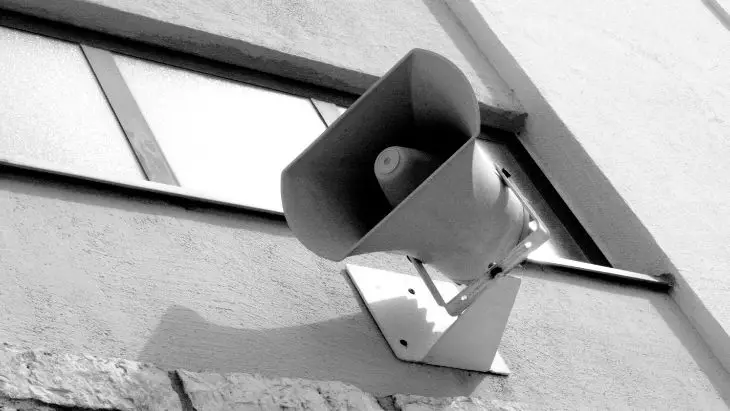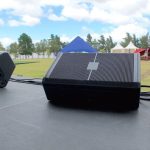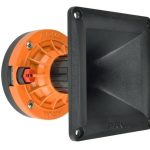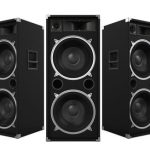Loudspeakers are special types of speakers designed to convert electrical signals into sound. Loudspeakers are often used as part of public address systems. They are ideal for delivering loud sound that can fill a large room or an outdoor venue. The actual performance of a loudspeaker depends on the design and build of the speaker itself. There’re several design approaches used in making loudspeakers. Consequently, there’re various types of loudspeakers available in the market today. Here’re the main types of loudspeakers available today.
1. Horn Loudspeakers

Horn loudspeakers are designed from the basic idea of a real animal horn. During historical times, animal horns were used to amplify sound. Horns are actually the oldest instrument used to amplify sound. The reason why a horn amplifies sound is its funnel shape. A horn is typically slim at the end and grows larger as the diameter goes towards its hollow opening. Their capability to amplify sound is actually what inspired sound engineers to manufacture horn loudspeakers. Horn loudspeakers are basically the oldest type of loudspeakers.
Components of a horn loudspeaker
A horn loudspeaker comprises a throat, neck, and mouth. The throat is the innermost and narrowest part of the speaker. The neck is the horn length and the mouth is the widest part of the horn, which is also the opening of the horn.
How does a horn loudspeaker work?
A horn works acoustically by transforming sound. As such, horn loudspeakers basically convert high pressure in the inner radiating area that looks like a cone to the larger outer opening that has low pressure. The neck part of a horn is small in size and this is the section that works as a compression driver.
The shape of a horn speaker expands outwards in diameter, thereby transforming high pressure at the neck such that it creates particle vibrations due to the high velocity in the smaller end. The particles vibrate at a lower pressure as they get distrusted towards the mouth to produce sound. The compression chamber of horn speakers can be a rear or front one while others don’t have a chamber. The chamber usually changes the frequency produced by the horn.
Horn loudspeakers are usually designed with different flare rates. Flare rate refers to the curve of the horn. The curve transforms energy from the driver in a certain way. Some curve designs include conical, parabolic, stepped, hyperbolic, and exponential curves. Conical and parabolic curve designs are easy to design, although they’re poor at converting impedance. Stepped curve designs have impressive impedance conversion. Hyperbolic and exponential curves also have good impedance conversation but have some non-linearity.
Different flare rates have different low-frequency outputs. They also differ in efficiency while others allow for uniform frequency response and minimal distortion. The size of the horn and its flare rate mainly depends on the purpose of the specific horn loudspeaker.
Designs for horn loudspeakers include straight, sideways, and folded forward. A straight design is where you can look through the horn opening and clearly see its throat. Folded designs are ideal for conserving enclosure space and at the same time marinating a lengthy speaker design for reproducing low-frequency sound. However, folded horn speakers are limited in terms of the frequency range.
Basically, the quality of sound that is delivered by a horn loudspeaker is determined by the horn direction, mouth design, flare rate, phase distortion, and the direction that the particle velocity takes at the mouth.
Horn loudspeakers produce nonlinear, resonant, and dispersive wave propagation. As such, they’re most ideal for manipulating sound direction and controlling wavefront properties. They have high acoustic power and their frequency range is wide enough. Thus, they’re ideal for outdoor use where the direction of sound matters most. However, they’re not ideal for low frequency. They mostly deliver piercing high frequencies that can disturb the ears when loud.
2. Moving Coil Loudspeakers
Moving coil loudspeakers are the most commonly used type of loudspeakers. They offer superb performance when well built. These loudspeakers come in different shapes and sizes, but they all operate under a similar principle. Let’s look at the moving coil loudspeakers in detail.

Components and design of moving coil loudspeakers
This type of loudspeaker comprises the following components:
1. Cone– The cone, also known as a diaphragm, is responsible for transferring vibrations from a coil to the air in a wide surface area. The exterior part of the speaker cone is usually attached to a rim. The rim is then attached to a frame. The cone is usually made of fabric, plastic, or paper. Some cones are also made of lightweight metal.
The best material for making the cone should be rigid enough to ensure it doesn’t produce uncontrolled vibrations. The material should also be lightweight to reduce the force required to move it. Also, the cone material should be properly damped to ensure its vibrations reduce once the force driving it comes to a halt or when there’s no audible signal within its frequency range. For instance, paper cones are light and properly damped but are not stiff whereas metal is stiff but poor in damping. As such, most cones are typically made of composite materials such as fiber.
2. Cone undulations– This is the part that allows the cone to move in a free, linear motion.
3. Magnet– It offers a magnetic field within which a coil moves. Most magnets are built to be permanent on the loudspeaker. Today, most magnets are made of ferrite material. Older magnets were made of Alnico and ceramic. The size of a magnet usually depends on the goals of the design.
4. Voice coil– The coil is the moving component of the loudspeaker. It moves within a magnetic field created by the magnet. It usually gets its current from an amplifier. The current within the magnetic field makes it move the cone to produce sound.
The voice coil usually comprises a lengthy, thin wire which is coiled together, thus the name voice coil. The most commonly used type of wire in making the coil is copper. Silver and aluminum are rarely used.
5. Dome– The dome, also known as a dust cap keeps the coil protected against dirt.
6. Suspension– The suspension is a kind of flexible support whose role is to hold the coil in place. It comprises a spider and a surround. The spider is flexible and allows the coil to move with ease. The surround ensures the coil is well centered in place and won’t come into contact with the magnet.
Most spiders are made of a form of fabric disk which is usually corrugated and stiffened with resin. The name spider originates from the shape of earlier suspensions that had 6 or 8 curved supports, making them look like a spider. The surround is usually made of fabric, polyester foam, or rubber. The interior diameter of the surround is basically fixed on the outer cone whereas its edges are fixed on the frame.
7. Frame– The frame, also referred to as the chassis, is the structure on which the loudspeaker components are built in place. The frame should be rigid enough to ensure the loudspeaker components are not deformed in any way since their alignment is important in the proper functioning of a loudspeaker.
How do moving coil loudspeakers operate?
These loudspeakers work by relying on the interaction between current from an amplifier and a magnetic field. Basically, the coil is centrally and uniformly placed within a magnetic field. As current from an amplifier flows through the coil, the coil starts moving as a result of the force generated within the magnetic field. The force corresponds to the current from the amplifier or audio source. The force creates movements on the coil which in turn makes the cone vibrate accordingly to produce sound.
3. Electrostatic Loudspeakers
An electrostatic loudspeaker operates by electrostatic interaction. It has a thin membrane that makes air move to produce sound.
How do electrostatic loudspeakers work?
These types of loudspeakers are made of a membrane that is thin in size and movable. The membrane is often made of Mylar material. The membrane is basically stretched between two stators. The stators are static in nature. They charge the membrane under high currents. As an audio current flows to the stators, they create an electrostatic field. The electrostatic field is usually varying in nature such that it pulls and pushes the membrane, thereby generating sound.
An electrostatic speaker has to be connected to AC to generate current. It also needs proper placement in a room to ensure it performs optimally. Also, the speaker is relatively insensitive and requires a powerful amplifier to drive it. The loudspeaker doesn’t require a crossover since the cone is fully powered by an audio current. This type of loudspeaker is usually driven on the overall surface of the membrane, unlike in moving coil loudspeakers where a small coil moves the cone. However, these speakers are limited in terms of cone excursion due to construction challenges. For instance, if the stators are built far apart from each other, they’ll demand more voltage to perform. Consequently, the stators form some arcs and tend to attract dust particles.
4. Planar Magnetic/Ribbon Loudspeakers
Planar magnetic loudspeakers are commonly referred to as ribbon loudspeakers. However, a ribbon loudspeaker is a type of planar magnetic loudspeaker. To understand the difference between these two loudspeakers, let’s have a look at each one of them in detail.
How do planar magnetic loudspeakers work?
These speakers usually have a flat cone with embedded conductors. The word planar is based on their flat and rectangular surface that moves frontwards and backward. The cone in these loudspeakers is typically a form of the membrane that has a voice coil embedded in it. The cone is usually placed between magnets. As the audio current passes through the coil, it reacts with the existing magnetic field generated by the magnet, making the membrane move repeatedly in uniform with the audio current. Consequently, the vibrations generate sound.
How do ribbon loudspeakers work?
The ribbon type of planar magnetic loudspeakers operates by using a strip as the cone. The strip, typically made of aluminum, is hung between two magnets. The strip is what is referred to as a ribbon. The ribbon may be pleated to make it stronger. As the audio current passes through the ribbon, a magnetic field is generated around it. The generated magnetic field reacts with the existing magnetic field of the two permanent magnets. As a result, the ribbon is pulled and pushed accordingly, thereby generating sound. Thus, in a ribbon loudspeaker, the ribbon works as a cone and voice coil.
Generally, the cone and voice coil in moving coil loudspeakers are heavier than the thin ribbon strips used in planar and ribbon loudspeakers. The lightweight nature of ribbons makes them respond more efficiently to the current flowing through them. The ribbons also stop vibrating as soon as the audio current stops flowing. These loudspeakers usually produce a quick and clean transition in frequency.
Although these loudspeakers offer superb sound, they have some shortcomings. For instance, their sensitivity is quite low, and this makes them demand more power from an amplifier. Also, the impedance of the ribbons is quite low. They’re quite challenging to place in a room since even the slightest variation in room placement may alter the sound quality significantly.
5. Bending Wave Loudspeakers
These are loudspeakers that use a flexible cone. The cone material has a rigidity that increases from its inner diameter toward the outer diameter. Short wavelengths are usually radiated from the inner diameter whereas longer wavelengths are radiated up to the edges. The damper that surrounds the cone absorbs longer wavelengths to prevent them from reflecting the inner diameter. Bending wave loudspeakers are ideal for producing an extremely wide frequency range. These loudspeakers are not very popular and only a few manufacturers make them today.
6. Flat Panel Loudspeakers
Sound engineers have for many years attempted to reduce the overall size of loudspeakers. Such desires led to the design of flat panel loudspeakers. These loudspeakers usually consist of a coil mounted on a flat panel. They can be easily hung on a wall since they’re not easily noticeable. However, the drivers in flat panel loudspeakers are more flexible when compared to cones made of similar material in cone-shaped speakers. Thus, it’s quite challenging to control resonance in these speakers, and this leads to some distortion. However, their popularity is quite low, although modern designs are using more rigid materials.
While there’re several types of loudspeakers, they all use both mechanical and electrical principles to transform audio current from a musical instrument, amplifier, or audio receiver into sound. As you can see, they all have their advantages and shortcomings. In the end, the kind of loudspeaker you should choose should depend on the intended use.
Michael Evanchuk is a San Francisco-based sound engineer with 20 years’ experience installing, troubleshooting, and repairing commercial, automotive, and household sound equipment. Evanchuk owns an auto stereo center, where he offers highly competitive car audio installation and repair services. He has written dozens of articles on different sound engineering topics, all of which have been published in leading journals, blogs, and websites.






